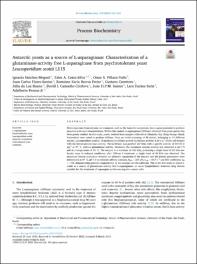“Antarctic yeasts as a source of L-asparaginase: Characterization of a glutaminase-activity free L-asparaginase from psychrotolerant yeast Leucosporidium scottii L115“

View/
Download
(application/pdf: 2.014Mb)
(application/pdf: 2.014Mb)
Date
2023-03-08Author(s)
Sanchez-Moguel, Ignacio
Costa-Silva, Tales A.
Pillaca-Pullo, Omar S.
Flores-Santos, Juan Carlos
Barros Freire, Rominne Karla
Carretero, Gustavo
Bueno, Júlia da Luz
Camacho-Cordova, David I.
Santos, Joáo H.P.M.
Sette, Lara Duraes
Pessoa-Jr., Adalberto
Metadata
Show full item recordAbstract
“Microorganisms from extreme environments, such as the Antarctic ecosystems, have a great potential to produce
enzymes with novel characteristics. Within this context, L-asparaginase (ASNase) obtained from yeast species has
been poorly studied. In this study, yeasts isolated from samples collected at Admiralty Bay (King George Island,
Antarctica) were tested to produce ASNase. From an initial screening of 40 strains, belonging to 13 different
species, Leucosporidium scottii L115 produced an ASNase activity (LsASNase activity: 6.24 U g-1 of dry cell weight)
with the lowest glutaminase activity. The LsASNase was purified 227-fold, with a specific activity of 137.01 U
mg-1 at 37 ◦C, without glutaminase activity. Moreover, the maximum enzyme activity was observed at pH 7.5
and at a temperature of 55 ◦C. The enzyme is a multimer of 462 kDa, presenting a single band of 53 kDa molecular mass in reduced conditions; after PGNase F treatment, a single band of 45 kDa was observed. The
enzymatic kinetic evaluation revealed an allosteric regulation of the enzyme and the kinetic parameters were
determined at 37 ◦C, pH 7.0 as substrate affinity constant, K0.5 = 233 μM, kcat = 54.7 s
− 1 and Hill coefficient, nH
= 1.52, demonstrating positive cooperativity by the enzyme and the substrate. This is the first study to report L.
scottii as a source of glutaminase-activity free L-asparaginase, an acute lymphoblastic leukemia drug feature
suitable for the treatment of asparagine synthetase negative cancer cells.“
Collections
- Web of Science (WOS) [236]

